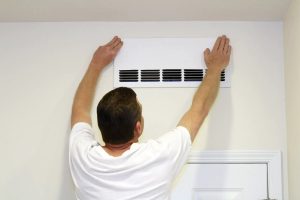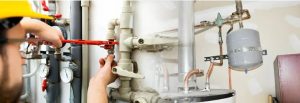Table Of Contents
- What Is A Rinnai Gas Heater?
- Who Manufactures The Rinnai Gas Heater?
- Advantages Of A Rinnai Gas Heater
- Reasons To Service A Rinnai Gas Heater
- Is It Important To Service A Gas Heater Regularly?
- The Main Parts Of A Rinnai Gas Heater
- Servicing The Ignitor Of The Rinnai Gas Furnace
- Replacing The Rinnai Gas Furnace Thermostat
- Gas Heater Repairs And Servicing
- Consult An Authorised Operator
What Is A Rinnai Gas Heater?
A gas heater is a heating system that uses natural gas or propane to heat up the air in your home. It is an alternative to electric heating systems. It can be a challenge to find the right heater for your home as a homeowner. With so many different types available, you can end up spending hours trying to decide which one is best for your needs.
The challenge overwhelms you further when you realise what an expensive purchase installing heating is. You want to get it correct the first time and make sure you get the biggest bang for your buck. If you’re considering installation or need maintenance, you can trust a Rinnai gas heater service Sydney to ensure everything runs smoothly.
Who Manufactures The Rinnai Gas Heater?

The Rinnai gas heater is a type of gas heater that the company of the same name has designed. They are manufactured in many different countries around the world, including Japan, Russia, Germany, and China.
Rinnai heaters are designed with three critical factors in mind – space, energy efficiency, and affordability. These heaters are perfect for homeowners looking for something that will work well in their space and save them money while doing so.
Advantages Of A Rinnai Gas Heater
The Rinnai gas heater is a revolutionary and efficient way to heat your home. It has many benefits that make it a better heating option than other heating systems.
- It is cost-effective compared to other types of heating systems because you only pay for gas as you use it. Gas prices are typically lower than electricity prices, so the Rinnai gas heater will save you money in the long run.
- The Rinnai gas heater is an eco-friendly option because it doesn’t produce any harmful emissions like CO2 or SO2.
- The Rinnai gas heater is also very safe and easy to install since it can be mounted on a wall or ceiling with minimal effort, and there is no need for special tools.
Reasons To Service A Rinnai Gas Heater
Rinnai gas heaters are great because they are well known for their longevity and high efficiency. They also come with different features, like the ability to adjust the temperature range, which is perfect for different environments.
If you’re looking for a reliable heater that will last you years without costing you too much in maintenance, then Rinnai gas heaters are perfect for you. This natural gas-powered appliance is environmentally friendly, safe to operate, and won’t overheat your home.
Specialists recommend regular servicing of a gas heater to ensure it safely gives you the best service. Call your gas heater specialist as your heater may require servicing if you happen to observe any problems with your gas heater including:
- There is a change in the colour of the flame. If you notice a yellow, red, or brown dirty colour, it is time to have your Rinnai gas heater checked.
- There are stains either on the unit or the surrounding area.
- You notice the heating system is overheating regularly.
- The pilot goes out every time.
- The pilot light either heats or surges whenever the heater is lit.
Is It Important To Service A Gas Heater Regularly?

Having your gas heater serviced regularly ensures that your home is safe. If there is a carbon monoxide leakage, which is toxic, it can be detected immediately. A series of tests are done during servicing, and the carbon monoxide leakage test is always on top of the list. A gas heater specialist will detect even the smallest of problems that can become a big problem down the line.
It will be more costly to do a major gas heater repair, so detecting and fixing it early might save you some money. Servicing will also ensure that you have heat whenever you need it. There is nothing as stressful as needing heat, and you find out your gas heater isn’t working.
Also, servicing helps prolong your gas heater’s life. The gas heater can serve you for years if they are taken care of, and this saves you money. On-time servicing of a gas heater will keep you from paying substantial repair bills as problems are noticed early in terms of repairs.
The Main Parts Of A Rinnai Gas Heater
The main components of a gas heater are the burner, combustion chamber, blower, and heat exchanger. Below is an explanation of how these components work together to provide heating.
Burner
The burner provides the heat source for the combustion chamber. It converts natural gas or propane into hot gases by burning it at a high temperature.
Combustion Chamber
The combustion chamber is where the burning takes place. It is made up of ceramic bricks lined with refractory cement to keep them from cracking under high heat.
Blower
A blower provides air to feed into the combustion chamber and mix with natural gas or propane before discharging air into various rooms.
Heat Exchanger
A heat exchanger transfers heat from the combustion chamber to the air surrounding your home. There should be minimal loss of heat during the process.
Servicing The Ignitor Of The Rinnai Gas Furnace
The ignitor of a Rinnai gas furnace is a device that creates an electric spark to ignite the gas, and it is one of the most critical parts of your furnace.
If you need to service your ignitor, then there are a few things that you need to do:
- Turn off and unplug your furnace.
- Remove the cover that protects the ignitor.
- Disconnect the wire from the bottom of the ignitor and remove it from its place.
- Put a new wire on top of it and reconnect it to its original position.
Detecting Ignitor Issues
The burners are usually at the front as soon as you open the access panel of most furnaces. You will notice that one end of the four burners is uncovered while the other end spreads out beyond a metal wall right into the burning space. You will see the ignitor attached to this wall near the first burner. It is also often located near the gas valve.
If you see a white porcelain base that is yellowish (due to age) with an extended metal bar that spreads into the track of the first burner, that is a hot surface ignitor. On the other hand, a spark ignitor appears the same as a hot surface ignitor; however, it has two bars that make the electrodes that produce the trigger.
The two ignitors have two sets of cables connected. If your furnace is old and has a pilot, the flame burning inside the firing chamber should be visible. Alternatively, you can locate the pilot by tracking any of the two thin copper ducts connected to the gas regulator.
Cleaning the Ignitor
A hot surface ignitor with a stove element will not stop working because it is dirty; however if it is coated with oil, it will not get as hot as you may require. You will notice that the furnace is slow to light when starting. This is a clear indication that it may be coated with carbon deposits. Here are two ways to clean your gas heater ignitor:
Using Compressed Air
One way of cleaning the ignitor is by using compressed air to blow out deposits. The compressed air cans have long applicators (that look like straws). You only need to direct the applicator straight to the probe, and blowing it up might just solve the problem.
The spark ignitor might also be covered with soot and, as a result, is not working well. You can try blowing it up with compressed air to remove the soot. If the pilot flame is burning dimly or does not light up, the compressed air can also unblock the pilot pipe and clean it. Direct the applicator right at the pilot opening and blow away.
Manual Cleaning
If you want to clean a hot surface ignitor manually, the first thing you need to do is switch off the furnace. You can easily achieve this by turning it off from the switch on the wall or turning off the beaker in the central panel that regulates the furnace.
Pull off the cables undo the screws holding the ignitor in place to disconnect the ignitor. The ignitor is very delicate, so lift it carefully and not touch the element with your open hands. This is because your fingers may have oil that can destroy certain old make surface ignitors.
Start by softly rubbing the ignitor probe using fine steel wool or emery material, but make sure you do not damage it. Remove the carbon and when you are satisfied, change the ignitor, join the connectors and switch on the power. Turn up the thermostat to test if the furnace is working. If it is still not working, you may be forced to purchase a new ignitor.
Replacing The Rinnai Gas Furnace Thermostat

The following steps will help you understand how to replace the thermostat on your Rinnai gas furnace.
- First, make sure that power to the furnace is turned off.
- Next, disconnect the wires from your old thermostat and attach them to the new one.
- Now, screw your new thermostat into place according to the instructions provided with it.
- Turn on power and test that it is working correctly.
Gas Heater Repairs And Servicing
If you notice your gas heater is not working correctly, it is time to look at it to establish the cause. Manufacturers recommend when a gas heater needs servicing (usually one or two years). This applies to all brands, including the Rinnai heater.
If you consult a technician, they should troubleshoot your gas heater for the following:
- Test if there is any carbon monoxide leakage.
- Check for dirty filters and flame sensors as well as clogged burners.
- Ensure gas pressure setting is correct.
- Examine for damage to the pilot injector and heat exchanger.
- Assess the thermocouple and fan motor for proper functioning.
Consult An Authorised Operator
All the parts that are not working should be replaced, and the technician should clean your gas heater including the filters, flues on flued heater models, and the burner. The expert should also check the pressure and other things depending on the model of the gas heater. To ensure you get the best out of your gas heater, it should be routinely serviced to check if it is working correctly and for safety.
When this service is done on time, it will ensure your family is safe and save you some cash by preventing gas heater replacements every time. For Rinnai gas heater service, ensure to consult an authorised operator. Go through the manual and check if you can do anything before calling an expert. If unsure, call in the nearest gas heater expert to assist.










